In this article:
Vitiligo is a skin condition that manifests as white patches on the skin. These white patches can appear on any part of the body, including your feet, legs, arms, lips, face, and mouth.
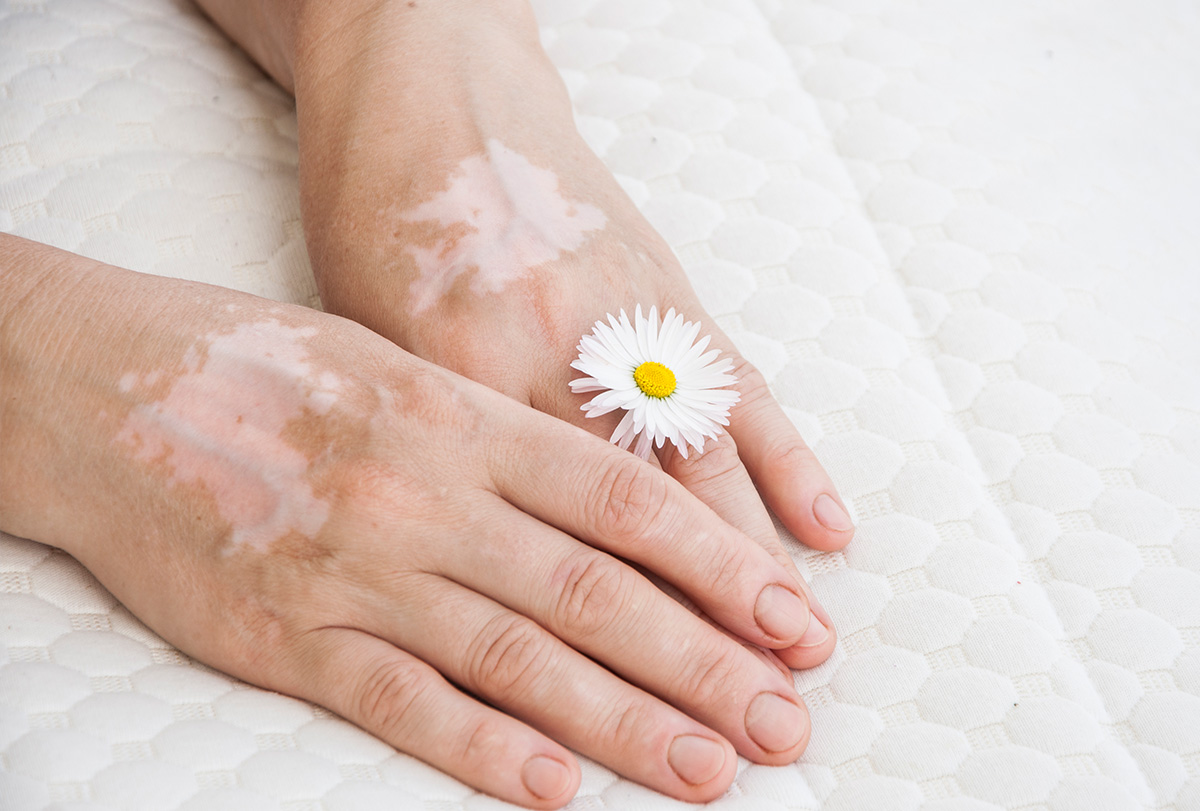
Vitiligo-caused white patches result from a lack of melanocytes. Melanin, produced by melanocytes, is a photoprotective pigment that is responsible for your skin color. A high accumulation of melanin results in a darker skin color, while low melanin gives rise to light skin.
The reason behind the development of vitiligo is not yet determined, but it is suspected that the condition may result from an autoimmune disorder wherein immune cells attack the melanocytes.
In addition, it has been found that people with vitiligo have high amounts of antioxidant enzymes in the serum. High oxidative stress in the body may lead to the degeneration of melanocytes, leading to the onset of vitiligo. (1)
Risk Factors for Vitiligo
The cause of vitiligo is still being studied, but various factors have been suspected to trigger it, including:
- Stress
- Genetic predisposition
- Prolonged, unprotected sun exposure
- Chemical irritation
- Vitamin B12 deficiency
- Immunotherapy
- Fungal infections such as eczema, tinea versicolor, or psoriasis
- Other skin conditions
Since vitiligo may result from a number of factors, it is essential to consult your doctor and get a proper diagnosis and treatment to avoid complications. Vitiligo treatment is also warranted if its appearance affects your self-confidence.
Medical Treatment for Vitiligo
It is essential to visit your doctor for a confirmed diagnosis of vitiligo. The doctor may prescribe treatment based on the severity of the disease, your age, and your medical history.
The treatment for vitiligo largely focuses on giving your skin an even tone and preventing it from spreading. However, it is quite difficult to treat vitiligo, and the treatments may not work and often have side effects.
Therefore, make sure to discuss the pros and cons of different treatment modalities with your doctor. Also, keep in mind that the treatments can take up to months or even a year to show results.
Your doctor may recommend one or more of the following treatment methods: (2)
1. Corticosteroids
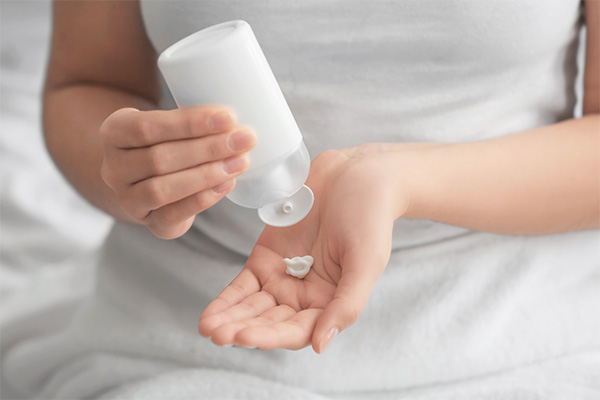
The topical application of anti-inflammatory corticosteroid ointments or creams can help restore the pigmentation in the affected areas, especially in the early stages. Alternatively, the doctor may suggest short courses of oral corticosteroids or corticosteroid injections for people with rapid vitiligo increase.
However, corticosteroids creams can cause stretch marks and thinning of the skin in the long run. Oral corticosteroids may increase the risk of weight gain, mood fluctuations, thinning of the skin, and cataracts.
2. Calcineurin inhibitors and vitamin D analogs
Calcineurin inhibitors, such as pimecrolimus and tacrolimus, when used topically can give the skin an even tone by restoring pigmentation in the affected areas. Vitamin D analogs, such as calcipotriene, may also be used.
These topical ointments are generally used for mild cases of vitiligo. While there is no risk of skin thinning such as that with corticosteroids, the long-term effects of these medications have not been studied yet.
In fact, tacrolimus and pimecrolimus are not FDA-approved treatments for vitiligo, and it is suggested that they may cause skin cancer or lymphoma. Therefore, these topical medications should be considered the last line of treatment and only in cases where other safer treatments fail to show results.
3. Light therapy
Different light therapies or phototherapies may help manage vitiligo and prevent its active spread. One such treatment is narrow-band ultraviolet B therapy.
Light therapy is more effective when combined with other medications or as a part of chemotherapy. These adjunct treatment modalities include khellin, (3)(4) muskmelon extract-based gels, (5) psoralen, azathioprine, prednisolone, calcineurin inhibitors, and corticosteroids. The doctor may also suggest sessions with an excimer laser or PUVA (psoralen and UVA) therapy.
Light therapy requires multiple sessions every week which may need to be continued for up to a year in some cases.
4. Depigmenting agents
If the white patches cover a large area and do not respond to any repigmentation treatment, the dermatologist may suggest lightening or depigmenting the unaffected skin to give it an even tone.
With the help of depigmenting or bleaching agents such as monobenzone and hydroquinone, your skin can be made lighter to match the vitiligo-affected areas. The treatment may take up to 9 months long, with one to two sessions each day.
The drawback of this treatment is that loss of melanin in the skin can make it highly sensitive to sunlight and also can increase the risk of skin cancer on UV exposure.
5. Needling
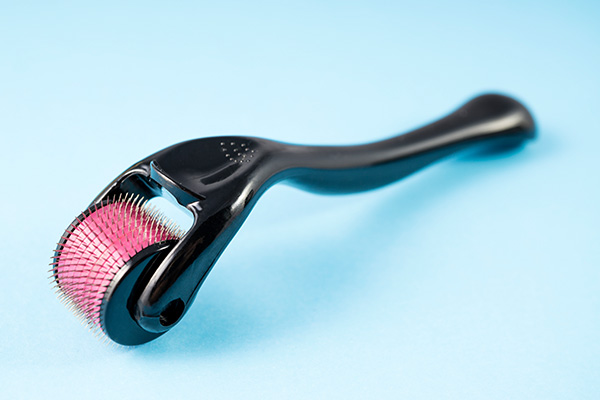
Needling involves the use of a medical-grade roller that contains numerous surgical needles on the affected areas. Skin needling can help improve the pigmentation of the white patches to some extent.
Needling is often used after the vitiligo spread is controlled and other treatments fail to repigment the skin. Since there is a risk of skin infections involved, needling should strictly be performed by licensed experts.
6. Surgery
The surgical treatment for vitiligo is suggested when the problem is localized, segmented, or stable, especially if vitiligo affects areas such as dorsal fingers, ankles, foreheads, and hairline, areas that do not repigment well.
The repigmentation may be performed through punch grafting, noncultured epidermal suspension, suction epidermal grafts, thin dermo-epidermal grafts, or cultured epidermis with melanocytes. The side effects of surgical treatment of vitiligo include infection, permanent scarring, cobblestone appearance, and even additional vitiligo patches in some cases.
Medical Treatments Underway
Aside from the conventional treatments mentioned above, a few treatment modalities are currently being studied and developed for vitiligo management, including:
- Prostaglandin E2-based gels. These may be useful in the repigmentation of the white patches in the early stages of vitiligo. (6)
- Implants. Made of compounds such as afamelanotide, implants may be inserted into the skin to boost the growth and production of melanocytes.
- JAK inhibitors. Generally used for the treatment of bone marrow disorders and rheumatoid arthritis, JAK inhibitors are being studied for the treatment of vitiligo as well. (7)
Home Remedies to Manage Vitiligo
Medical treatment for vitiligo is vital, but you can also use the following natural ingredients and home remedies as adjunct treatment modalities to better manage the condition.
Note: Make sure to consult your doctor on the use of herbal remedies or supplements as they may react with your medications and inhibit their actions or cause problems.
1. Ginkgo biloba

Vitiligo is suspected to occur due to autoimmune problems or increased oxidative stress in the body. Ginkgo biloba supplements possess antioxidant and immunomodulatory properties that can help in the management and control of vitiligo. (8)(9)
In addition, Ginkgo biloba is found to help increase pigment in the skin. Ginkgo biloba herbal supplements are found to be safe for the treatment of nonsegmented vitiligo. However, the supplements may react with antiplatelet and anticoagulant medications and therefore should be used only upon the recommendation of your doctor, who will determine the correct dosage for your condition.
2. Polypodium leucotomos
Polypodium leucotomos possesses photoprotective and antioxidant properties, and for this reason, it has been long used as an adjuvant therapy to phototherapy for people with vitiligo. (10)
A study demonstrated that the use of Polypodium leucotomos extract-based oral supplements helped increase pigmentation in the head and neck area of people with vitiligo vulgaris, especially those with a light skin type, when used together with laser or phototherapy. (11)
3. Vitamin B12 and folic acid
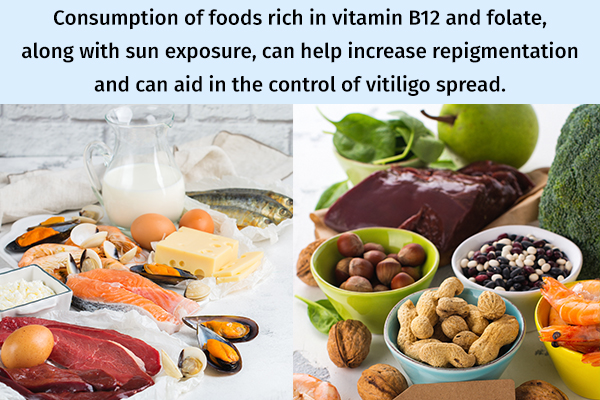
Scientific studies show that an increase in the consumption of foods rich in vitamin B12 and folate, along with sun exposure (especially direct sunlight), can help increase repigmentation and can aid in the control of vitiligo spread. (12)(13)
In addition, the use of vitamin B12 can help reduce anxiety in people who may have depression symptoms due to the social aspects of vitiligo. Therefore, it is suggested to include foods containing high amounts of folic acid and vitamin B12 in your diet. You can also take supplements upon the recommendation of your doctor.
4. Zinc and copper
People with vitiligo are found to have low serum levels of zinc, (14) a micronutrient essential for boosting cell repair, immune system function, and the prevention of cancer.
Moreover, optimum zinc levels in the body help in the production of melanin in the skin. It is therefore essential to maintain appropriate zinc levels in the body to help treat and prevent vitiligo. (15) Similarly, copper is shown to boost melanin production, thus helping in the repigmentation of the skin.
5. Vitamin C and other antioxidants

Similar to zinc deficiency, vitamin C deficiency is commonly associated with vitiligo. Moreover, it has been observed that the use of vitamin C supplements improved the efficacy of short-term phototherapy treatments for vitiligo, including UVB irradiation.
This usefulness of vitamin C may result from its antioxidant properties, since increased oxidative stress is often associated with the onset of vitiligo and the accumulation of hydrogen peroxide in people with active vitiligo. (16)
In addition to vitamin C, other antioxidant oral and topical medications may help. (17) Antioxidants can also be found in foods such as artichokes, berries, dark unsweetened chocolate, kale, mangoes, grapes, guavas, apricots, nuts, and other foods rich in vitamin E and beta carotene.
Note: People with glucose 6-phosphate dehydrogenase deficiency, renal problems, or paroxysmal nocturnal hemoglobinuria should avoid vitamin C use as it can cause poisoning. (18)
6. Black cumin or fish oil
Studies show that the topical application of black cumin (Nigella sativa) oil and fish oil to the affected areas can help reduce the size of the white patches when used as an adjunct to medical treatment. (19)
The use of nigella oil is preferred as it is observed to be more effective than fish oil. This may result from its thymoquinone content, which helps prevent oxidative damage in cells.
While the studies on the use of black cumin and fish oil in the treatment of vitiligo are limited, the oils are generally safe for use and can be given a try if you are not allergic to them.
7. Alpha-lipoic acid
The use of alpha-lipoic acid as an adjunct therapy to medical treatment is often suggested due to its antioxidant properties that help preserve melanocytes from oxidative damage.
You can increase your intake of alpha-lipoic acid through tea, beer, wine, spinach, fruits, soy, broccoli, yeast, and organ meats such as kidney and liver. (20)
Self-Care Measures
In addition to getting treated for vitiligo, it is essential to take some self-care measures that aid recovery and also prevent further spread of the disease.
1. Use sunscreen
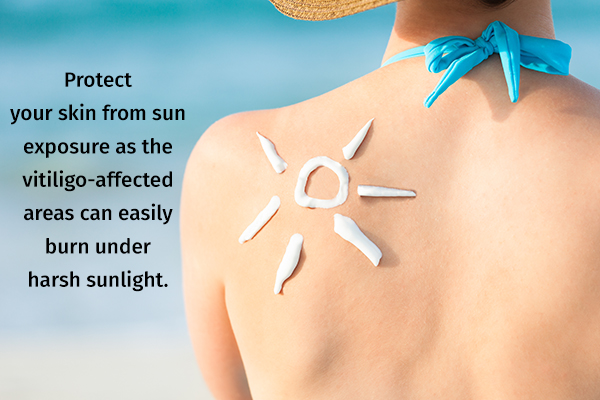
Protect your skin from sun exposure as the vitiligo-affected areas can easily burn under harsh sunlight. Use heavy-duty sunscreen with SPF 30 or higher.
You can use zinc- and titanium-based gels, ointments, or moisturizers on your skin to protect it from sun damage and reduce the pigmentation difference between the affected and unaffected skin.
2. Wear sun-protective gear
In addition to the use of sunscreen, wear full-sleeved clothing, cotton gloves, and wide-brimmed hats if you are going to stay under the sun for long periods.
3. Avoid tanning
While protecting your skin from sun exposure is important, it is also necessary to refrain from using artificial tanning beds or sunbeds. These artificial tanning methods use UV rays, which may damage your vitiligo-affected skin instead of increasing pigmentation.
4. Refrain from getting tattoos
Avoid getting tattoos, which can trigger an increase in vitiligo patches. This also applies to micropigmentation, a treatment method used to introduce pigments to the affected areas, as there is an increased risk of aggravating your vitiligo.
5. Get enough vitamin D

Protecting your skin from sun exposure is very important, but you must not avoid it completely as it can result in a vitamin D deficiency (the sun is the major source of vitamin D). You can, however, consume vitamin D-rich foods such as milk and oily fish to help maintain the vitamin D levels in your body.
6. Consume green tea
Intake of green tea can help prevent the spread of vitiligo patches. (21)
Miscellaneous Treatment Modalities
In addition to medical treatment, the following treatment modalities may be used for the management of vitiligo:
1. Ayurvedic treatment
Traditional Ayurvedic treatments use herbs to control and treat vitiligo. These herbs may help repigment the skin and prevent spread of the disease.
Caution: While some of these herbs have been scientifically tested, others are yet to be studied. Therefore, it is best to consult your doctor on the use of herb-based supplements as they may have side effects such as liver damage.
The Ayurvedic herbs commonly used for vitiligo treatment include:
2. Stress management

Vitiligo not only worsens with increased stress, but it may itself cause stress, depression, or anxiety by causing poor self-esteem in those affected, leading to a vicious cycle. (26) Therefore, stress management is a vital part of vitiligo treatment.
The following methods may help manage your stress better:
- Yoga
- Meditation
- Tai-chi
- Aromatherapy using essential oils such as rosemary and lavender
- Massage
- Regular exercise
- Cognitive behavior therapy
- Talk therapy
- Support groups
3. Skin camouflages
Several skin camouflage products can cover the discoloration temporarily. These products come in a wide range of colors and are generally water resistant, ensuring long wear of up to 5 days. You can consult your dermatologist on such products. In addition, you can use FDA-approved self-tanning products that contain dihydroxyacetone. (27)
Most-Asked Questions About Vitiligo
Can OTC sunlamps help in the treatment of vitiligo?
OTC sunlamps are portable or handheld devices that emit narrow-band UVB light and can therefore be used for phototherapy at home. However, these OTC devices are not as effective as professional therapies and are therefore not recommended. Moreover, OTC sunlamps are not FDA-approved and may have long-term effects on your skin.
Is red clay helpful in the management of vitiligo-caused hypopigmentation?
Red clay is often used as a skin camouflage, which, owing to its copper content, is also thought to help repigment the skin. However, this claim is based on anecdotal evidence and not supported by any scientific trials.
To use red clay, mix it with ginger juice in a 1:1 ratio and apply it to the affected areas. Wash off the paste once dry.
Can the application of turmeric help restore skin pigmentation?
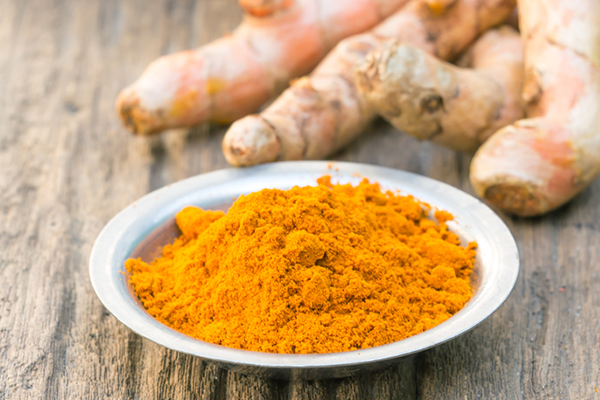
Curcumin, the active compound of turmeric, is being studied for antivitiligo effects, but the mere use of turmeric paste on vitiligo patches may not be effective. However, you can consume turmeric for its antioxidant effects to help lower oxidative stress in the body.
More research is required to establish the effects of turmeric application and consumption for the treatment of vitiligo. However, a tetrahydrocurcumide cream is being used with UVB therapy and is seen to help boost repigmentation to some extent. (28)
Final Word
Vitiligo is a common skin problem that occurs due to melanocyte degradation in the skin, leading to a lack of melanin, the pigment that gives your skin its color. This leads to the formation of white patches on the skin.
Vitiligo can result from autoimmune disorders, oxidative stress, or vitamin deficiency in the body and can affect people to different extents. There is no cure for vitiligo yet, but several treatments can help control its spread. While vitiligo doesn’t pose a direct threat to your health, there is an associated increased risk of sunburns.
Moreover, people with vitiligo may suffer from social anxiety, warranting proper treatment. Consult your doctor on the suitable treatment modality for you, its pros and cons, and other adjunct treatments that you may follow for better management of the problem.
- Was this article helpful?
- YES, THANKS!NOT REALLY


